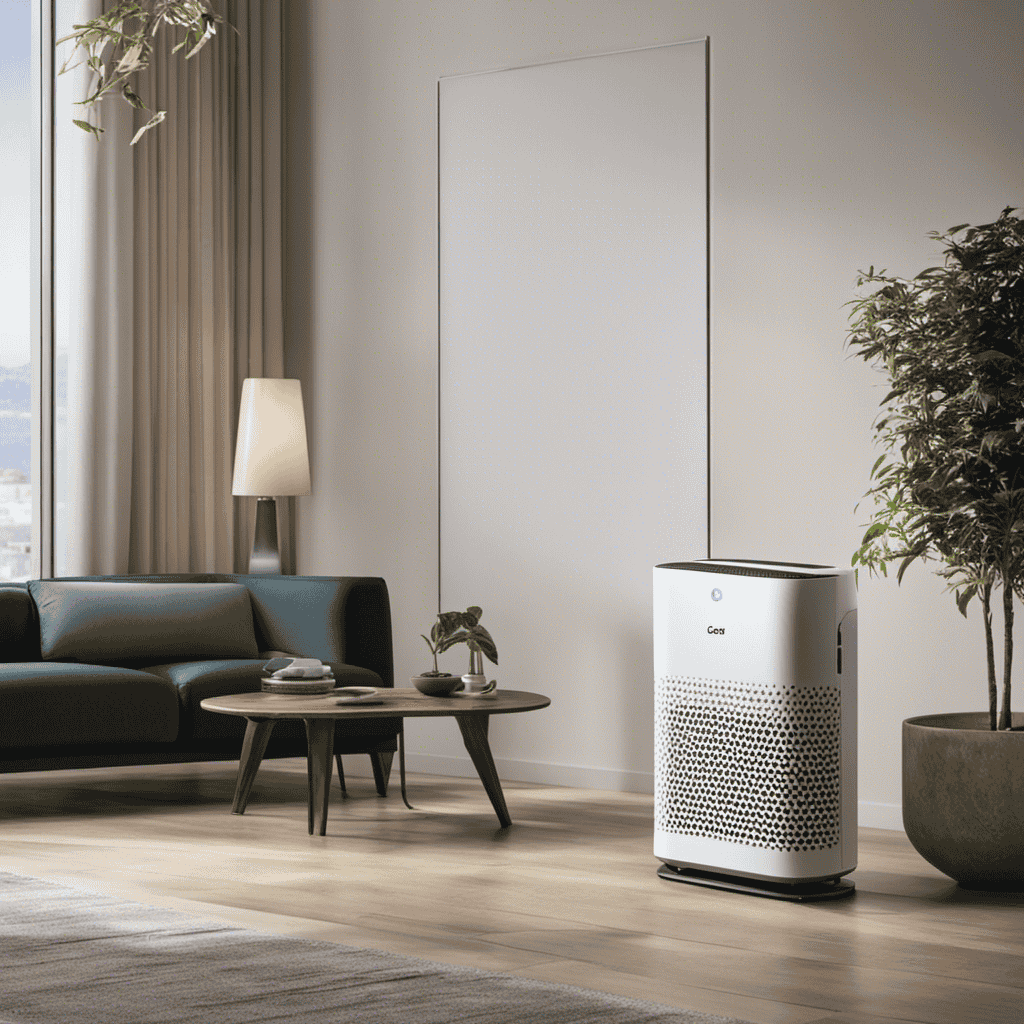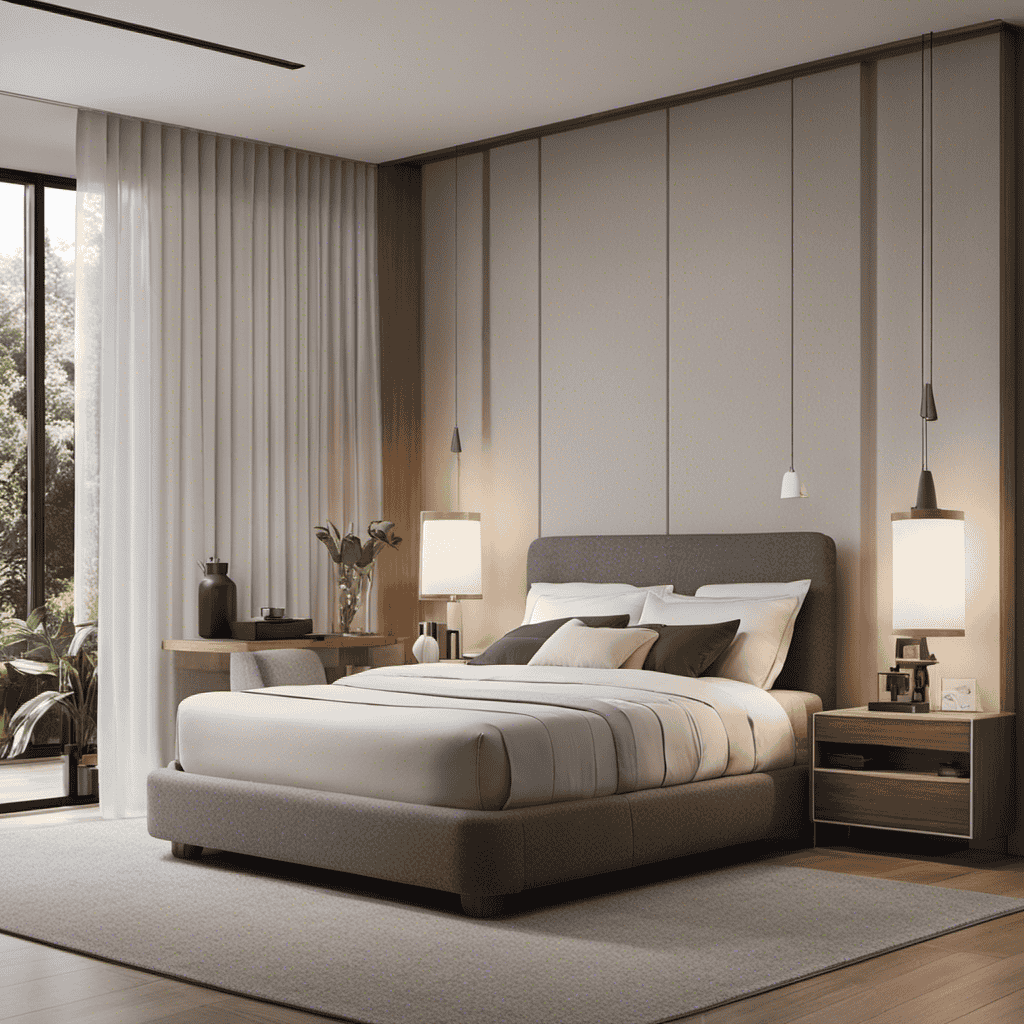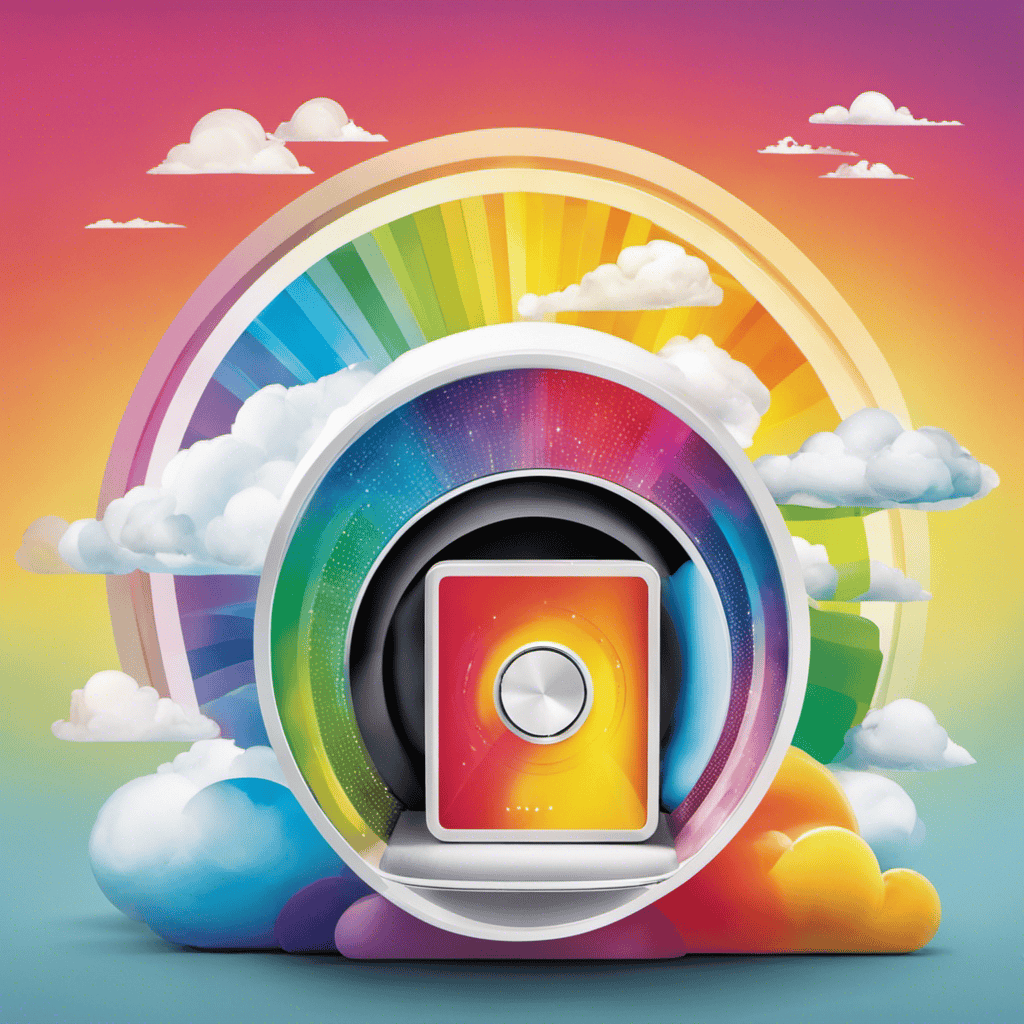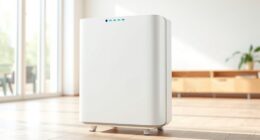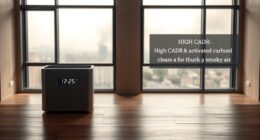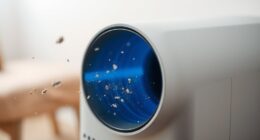I have some exciting news for you – CADR ratings for air purifiers are extremely important! If you want to enhance the air quality in your home, knowing about CADR ratings is crucial.
In this article, I’ll delve into how CADR ratings measure the performance of air purifiers, the factors to consider before choosing one based on CADR ratings, and the importance of these ratings in removing smoke and odor. Let’s debunk common misconceptions and explore how CADR ratings differ from HEPA filters.
Plus, I’ll share tips to maximize the effectiveness of high CADR-rated air purifiers. Are CADR ratings the sole indicator of efficiency? Get ready to find out!
Key Takeaways
- CADR ratings measure the efficiency of air purifiers in removing particles from the air.
- High CADR ratings can benefit individuals with allergies or asthma by reducing allergens and improving indoor air quality.
- Factors such as room size, type of pollutants, and speed settings can impact CADR ratings.
- When choosing an air purifier, consider the specific pollutants you want to target and the size of your room, and take into account the CADR rating for efficient pollutant removal.
Understanding CADR Ratings
Understanding CADR ratings is important when choosing an air purifier. CADR, or Clean Air Delivery Rate, is a measure of how efficiently an air purifier can remove particles from the air. There are several factors that can impact the accuracy of CADR ratings.
One factor is the size of the room in which the air purifier will be used. CADR ratings are based on a standard room size, so if your room is larger or smaller than the standard size, the actual CADR performance may differ.
Another factor is the type of particles being filtered. CADR ratings are typically given for three types of particles: smoke, pollen, and dust. If your air purifier needs to filter other types of particles, such as pet dander or mold spores, the CADR ratings may not accurately reflect its performance.
Despite these limitations, high CADR ratings can provide several benefits. A higher CADR rating means that the air purifier can remove particles from the air more quickly and efficiently. This is especially important for people with allergies or asthma, as a high CADR rating can help to reduce allergens and improve indoor air quality. Additionally, air purifiers with high CADR ratings can help to eliminate odors and other unpleasant smells from the air.
How CADR Ratings Measure Air Purifier Performance
When it comes to choosing an air purifier, understanding the CADR rating is of utmost importance.
The CADR rating, or Clean Air Delivery Rate, measures an air purifier’s effectiveness in removing specific pollutants from the air.
Several factors can affect the CADR rating, including the size of the room, the type of pollutants present, and the speed settings of the purifier.
Therefore, it is crucial to consider these factors when selecting the right air purifier for your needs.
CADR Rating Importance
The CADR rating is important because it indicates the air purifier’s effectiveness in removing pollutants from the air. A higher CADR rating means the air purifier can remove a larger volume of airborne particles per minute.
Several factors influence CADR ratings, including the size of the air purifier, the type and quality of the filters used, and the fan speed. A larger air purifier with multiple filters and a high-powered fan will usually have a higher CADR rating.
The benefits of a high CADR rating include faster removal of pollutants, improved indoor air quality, and reduced allergy and asthma symptoms. By efficiently filtering out particles like dust, pollen, and smoke, air purifiers with high CADR ratings can provide cleaner and healthier air for you and your family.
Transitioning into the next section, let’s explore the factors that can affect CADR ratings even further.
Factors Affecting CADR
Factors affecting CADR include the size of the purifier, the quality of filters, and the speed of the fan.
When it comes to air purifiers, these factors play a crucial role in determining their effectiveness in removing airborne pollutants.
The size of the purifier is important because it determines the volume of air that can be processed. A larger purifier can handle more air, resulting in a higher CADR.
The quality of filters is also essential as it determines the level of filtration and the types of pollutants that can be removed. High-quality filters with multiple layers can effectively capture a wide range of particles.
Additionally, the speed of the fan affects the CADR by determining the rate at which air is circulated and purified. A higher fan speed can result in a higher CADR.
Therefore, when considering an air purifier, it is crucial to consider these factors to ensure optimal performance and reap the benefits of high CADR ratings.
Choosing the Right Purifier
To ensure optimal performance, it’s crucial to consider these elements when selecting the right purifier.
Factors influencing air quality play a significant role in choosing the most suitable air purifier for your space. First and foremost, you need to identify the specific pollutants you want to target. Dust, pollen, pet dander, and mold spores are common indoor pollutants that can affect air quality.
Understanding the size of your room is also essential, as it determines the purifier’s capacity to clean the air effectively. Additionally, you should consider the Clean Air Delivery Rate (CADR) of the purifier, which measures its efficiency in removing pollutants. By selecting a purifier with a higher CADR, you can benefit from improved air quality and a healthier living environment.
Factors to Consider Before Choosing an Air Purifier Based on CADR Ratings
Before choosing an air purifier based on CADR ratings, it’s important to consider several factors. While the CADR (Clean Air Delivery Rate) is a useful metric for evaluating the efficiency of an air purifier, there are other factors that should be taken into account to make an informed decision.
Factors influencing CADR ratings:
-
Filter type: The type of filter used in an air purifier can greatly influence its CADR rating. HEPA (High-Efficiency Particulate Air) filters are known for their high efficiency in capturing airborne particles, leading to higher CADR ratings.
-
Room size: The size of the room where the air purifier will be used is another important factor. A larger room requires an air purifier with a higher CADR rating to effectively clean the air.
-
Pollutant types: Different air purifiers excel at removing specific types of pollutants, such as dust, pollen, or smoke. Consider the specific pollutants you want to eliminate and choose an air purifier with a CADR rating that matches your needs.
Benefits of high CADR ratings:
-
Faster purification: Air purifiers with high CADR ratings can clean the air more quickly, providing you with cleaner and healthier air in a shorter amount of time.
-
Improved air quality: Higher CADR ratings indicate better filtration efficiency, meaning more pollutants are removed from the air, resulting in improved indoor air quality.
-
Allergy relief: Air purifiers with high CADR ratings can effectively remove allergens from the air, providing relief for allergy sufferers.
Considering these factors and the benefits of high CADR ratings will help you choose an air purifier that meets your specific needs and provides optimal air purification.
The Importance of CADR Ratings in Improving Indoor Air Quality
When considering the cleanliness of your indoor air, it’s important to understand the significance of CADR ratings in improving air quality. CADR, or Clean Air Delivery Rate, is a measure of an air purifier’s effectiveness in removing airborne pollutants from a room. It is determined by testing the purifier’s ability to remove smoke, pollen, and dust particles. Higher CADR ratings indicate a faster and more efficient purification process.
CADR ratings are influenced by various factors that can affect the performance of an air purifier. The size of the room, the level of pollutants present, and the fan speed of the purifier all play a role in determining the CADR rating. It’s important to choose an air purifier with a CADR rating that matches the size of your room and the specific allergens you are targeting.
To illustrate the impact of CADR ratings on air quality, consider the following table:
| Air Purifier | CADR Rating for Smoke | CADR Rating for Pollen | CADR Rating for Dust |
|---|---|---|---|
| Model A | 200 | 180 | 190 |
| Model B | 150 | 200 | 170 |
| Model C | 180 | 160 | 220 |
As you can see, Model C has the highest CADR rating for dust, indicating its superior ability to remove dust particles from the air. This information is crucial for individuals with allergies, as higher CADR ratings can provide better relief from allergens.
Common Misconceptions About CADR Ratings
When it comes to evaluating the effectiveness of air purifiers, CADR ratings are often used as a benchmark. However, it is important to understand that CADR ratings do not necessarily reflect the overall effectiveness of an air purifier in improving indoor air quality.
While CADR numbers provide a measure of how quickly an air purifier can remove specific airborne pollutants, they do not take into account factors such as room size, filtration efficiency, or the presence of other pollutants.
Therefore, it is crucial to consider other factors in addition to CADR ratings when selecting an air purifier for optimal effectiveness.
CADR Vs. Effectiveness
The CADR rating determines how effective an air purifier is at removing contaminants. When comparing CADR ratings, it’s essential to consider other factors that can affect an air purifier’s performance.
Here are three key points to keep in mind:
-
CADR ratings vs. energy consumption: Higher CADR ratings often indicate better air purification performance. However, it’s crucial to balance this with energy consumption. Look for air purifiers that have high CADR ratings while still being energy efficient, ensuring cleaner air without burning a hole in your pocket.
-
CADR ratings and air purifier noise levels: Some air purifiers with high CADR ratings may generate more noise due to the powerful fans required to achieve efficient air purification. Consider your noise tolerance level and choose an air purifier that strikes a balance between high CADR ratings and acceptable noise levels.
Understanding CADR Numbers
To understand CADR numbers, you should know that they measure the effectiveness of removing contaminants from the air. Several factors can affect CADR ratings, including the size of the room, the type and number of pollutants present, and the air purifier’s filter efficiency.
A larger room may require a higher CADR rating to effectively clean the air. Additionally, certain pollutants, such as smoke or pollen, may be more challenging to remove than others. To improve CADR ratings, consider choosing an air purifier with a higher CADR value or multiple units for larger rooms. It’s also important to regularly clean or replace the filters to maintain optimal performance.
Understanding these factors and implementing these tips can help you select an air purifier with the right CADR rating for your needs, ensuring cleaner and healthier air in your home.
Understanding CADR numbers and their impact on allergies and asthma is crucial for those seeking relief from these respiratory conditions.
How CADR Ratings Impact Allergies and Asthma
CADR ratings directly affect the effectiveness of air purifiers in managing allergies and asthma. These ratings provide essential information about how well an air purifier can remove airborne particles, such as pollen, dust, and pet dander, from the indoor air. As someone who suffers from allergies and asthma, I understand the importance of having clean air to breathe.
The impact of CADR ratings on respiratory health cannot be understated. Here are a few key points to consider:
-
CADR ratings determine the speed at which an air purifier can remove pollutants from the air. The higher the CADR numbers, the faster the air purifier can clean the indoor air. This means that a purifier with high CADR ratings can provide quicker relief from allergens and irritants, reducing the risk of asthma attacks and allergic reactions.
-
Indoor air pollution can trigger respiratory symptoms and worsen allergies and asthma. With the right air purifier, you can significantly reduce indoor air pollution by removing harmful particles and allergens. CADR ratings help you identify the most effective air purifiers for improving the air quality in your home.
-
Investing in an air purifier with high CADR ratings is a proactive measure to protect your respiratory health. By choosing a purifier with the appropriate CADR ratings for your room size, you can create a cleaner and healthier indoor environment, reducing the impact of allergies and asthma on your daily life.
Comparing CADR Ratings for Different Air Purifier Brands
When comparing different air purifier brands, you’ll want to look for the ones with the highest CADR ratings. CADR, or Clean Air Delivery Rate, is a measurement that tells you how effective an air purifier is at removing airborne pollutants from a room. It is an important factor to consider when choosing the right brand for your needs.
There are some misconceptions about CADR ratings that you should be aware of. One common misconception is that a higher CADR rating automatically means better air purification. While a higher CADR rating generally indicates a more effective air purifier, it doesn’t guarantee that it will be the best choice for your specific needs. Other factors such as the size of the room and the types of pollutants you want to remove should also be taken into consideration.
To compare CADR ratings for different air purifier brands, you can look for the CADR values provided by the manufacturers. These values are usually expressed in cubic feet per minute (CFM) and indicate the rate at which the air purifier can remove pollutants. The higher the CFM value, the faster the air purifier can clean the air in a room.
What CADR Ratings Mean for Smoke and Odor Removal
When it comes to smoke and odor removal, understanding CADR ratings is crucial.
CADR, or Clean Air Delivery Rate, measures how effectively an air purifier can remove specific pollutants from the air.
A higher CADR rating indicates a more efficient air purifier in terms of removing smoke particles and eliminating odors.
Therefore, when choosing an air purifier for smoke or odor removal, paying attention to CADR ratings is essential for ensuring optimal performance.
CADR and Smoke Efficiency
The smoke efficiency of air purifiers is an important factor to consider when choosing the right one. When it comes to smoke filtration, the CADR (Clean Air Delivery Rate) rating is a key metric to look for. A higher CADR rating indicates that the air purifier is more efficient in removing smoke particles from the air.
This can be particularly beneficial for individuals with allergies or sensitivities to smoke. A higher CADR rating means that the air purifier can filter smoke particles at a faster rate, reducing the amount of smoke in the air and potentially alleviating symptoms.
When choosing an air purifier, consider the CADR rating and its impact on smoke efficiency to ensure optimal air quality and a healthier living environment.
- High CADR rating ensures faster smoke particle removal
- Reduced smoke in the air can alleviate allergy symptoms
- Optimal air quality is crucial for a healthier living environment
Odor Removal Effectiveness
To ensure optimal odor removal, you should consider the effectiveness of air purifiers in eliminating unwanted smells.
Air purifier technology has advanced significantly in recent years, allowing for better indoor air quality.
Indoor air pollution, which can include odors from cooking, pets, or tobacco smoke, can be effectively reduced with the right air purifier.
When selecting an air purifier for odor removal, it is important to look for specific features such as activated carbon filters or photocatalytic oxidation technology.
These features are designed to target and eliminate odors by trapping or breaking down the odor-causing molecules.
Additionally, air purifiers with higher CADR (Clean Air Delivery Rate) ratings are more efficient in removing odors as they can circulate and filter the air more quickly.
CADR Ratings Vs. HEPA Filters: What’s the Difference
There’s a significant difference between CADR ratings and HEPA filters. When it comes to the effectiveness of air purifiers, understanding this difference is crucial.
CADR, or Clean Air Delivery Rate, measures the speed at which an air purifier can remove specific particles from the air. On the other hand, HEPA filters are high-efficiency filters that can capture particles as small as 0.3 microns with 99.97% efficiency.
To better comprehend the disparity between CADR ratings and HEPA filters, consider the following:
- CADR ratings provide a general indication of an air purifier’s performance, but they do not guarantee the removal of all harmful particles.
- HEPA filters, on the other hand, are proven to effectively capture a wide range of pollutants, including allergens, pet dander, and even some viruses.
It is important to note the limitations of CADR ratings:
- CADR ratings only measure the removal of three specific particles: smoke, pollen, and dust.
- They do not account for the removal of other harmful particles, such as bacteria, mold spores, or volatile organic compounds (VOCs).
- CADR ratings do not consider the air purifier’s ability to filter out particles smaller than 0.3 microns.
Tips for Maximizing the Effectiveness of an Air Purifier With High CADR Ratings
Now that we understand the difference between CADR ratings and HEPA filters, let’s discuss some tips for maximizing the effectiveness of an air purifier with high CADR ratings.
By following these maintenance tips, you can ensure that your air purifier operates at its peak performance and maximizes energy efficiency.
Firstly, it is essential to regularly clean or replace the filters in your air purifier. Over time, filters can become clogged with dust, pollen, and other particles, reducing the purifier’s effectiveness. By cleaning or replacing the filters as recommended by the manufacturer, you can maintain optimal air quality.
Secondly, keep the air purifier in a central location within the room to ensure efficient air circulation. Placing it near a wall or furniture obstructs the airflow, reducing its ability to purify the air effectively.
Additionally, avoid running the air purifier on high settings continuously. Most models have different speed settings, and running it on the lowest effective setting can save energy while still maintaining clean air.
Lastly, consider using the air purifier in conjunction with other energy-efficient practices, such as sealing windows and doors to minimize outdoor air infiltration.
Are CADR Ratings the Sole Indicator of Air Purifier Efficiency?
Regularly cleaning or replacing filters is essential for maintaining optimal performance in high CADR rated air purifiers. However, it is important to note that CADR ratings are not the sole indicator of air purifier efficiency. There are several factors that can influence the overall effectiveness of an air purifier.
-
Room size: The size of the room plays a crucial role in determining the efficiency of an air purifier. If the purifier is not appropriately sized for the room, it may not be able to effectively clean the air.
-
Air quality: The initial air quality in a room can also impact the efficiency of an air purifier. If the air is heavily polluted or contaminated, the purifier may have to work harder to achieve clean air.
-
Maintenance: Regular maintenance of the air purifier is essential for optimal performance. This includes not only cleaning or replacing the filters but also cleaning the unit itself to prevent the buildup of dust and debris.
While CADR ratings provide a useful benchmark for comparing air purifiers, they have their limitations. These ratings only measure the purifier’s ability to remove specific particles such as smoke, dust, and pollen. They do not take into account the purifier’s ability to remove gases, odors, or volatile organic compounds (VOCs).
What Are the Best Air Purifiers with High Cadr Ratings?
Looking for the best air purifier with high CADR ratings? Look no further! Our selection of air purifiers with high CADR ratings ensures that you’ll be breathing in clean, purified air in no time. Say goodbye to allergens and impurities with these top-rated air purifiers.
Frequently Asked Questions
Can CADR Ratings Be Used to Compare Air Purifiers With Different Types of Filters?
Yes, CADR ratings can be used to compare air purifiers with different types of filters. CADR stands for Clean Air Delivery Rate and it measures the effectiveness of different air purifier models in removing specific air contaminants.
Do CADR Ratings Take Into Account the Size of the Room Where the Air Purifier Will Be Used?
Do CADR ratings take into account the size of the room where the air purifier will be used?
This is an important consideration when evaluating the effectiveness of air purifiers. However, CADR ratings do not directly factor in the room size. Instead, they measure the rate at which an air purifier can remove pollutants from the air.
It’s important to note that CADR ratings do not affect the energy consumption of air purifiers and have limitations in determining overall effectiveness.
Are There Any Alternative Ratings or Measurements to Consider When Choosing an Air Purifier?
When considering air purifiers, it’s important to explore alternative measurements and effectiveness comparisons.
While CADR ratings provide valuable information about a purifier’s ability to remove pollutants, there are other factors to consider.
One alternative measurement is the ACH (Air Changes per Hour), which indicates how many times the purifier can clean the air in a given space.
Additionally, looking at the efficiency of the filter and the purifier’s noise level can help make a more informed decision.
Can CADR Ratings Be Influenced by Factors Such as Temperature or Humidity?
Influence of environmental factors on CADR ratings and the impact of air purifier settings are important considerations.
Factors such as temperature and humidity can indeed influence CADR ratings. Higher temperatures can decrease the effectiveness of air purifiers, while higher humidity levels can enhance their performance.
Additionally, air purifier settings, such as fan speed and filter type, can also affect CADR ratings.
Therefore, it is crucial to take into account these environmental factors and adjust the settings accordingly to optimize the performance of the air purifier.
How Frequently Should an Air Purifier’s Filters Be Replaced to Maintain Its CADR Rating?
To maintain the CADR rating of an air purifier, it’s crucial to replace the filters regularly. Extending the lifespan of air purifier filters can be achieved by following a few simple steps.
Firstly, ensure proper maintenance of the air purifier, including regular cleaning of the filters.
Secondly, monitor and improve the air quality in your environment. Factors such as temperature and humidity can impact the effectiveness of air purifiers, so maintaining optimal conditions can help prolong the lifespan of the filters.
Conclusion
In conclusion, CADR ratings play a crucial role in evaluating the efficiency of air purifiers. They provide a quantitative measurement of an air purifier’s performance in removing common pollutants from indoor air. By considering factors such as room size and specific pollutant needs, one can choose an air purifier with the appropriate CADR rating.
However, it is important to note that CADR ratings are not the sole indicator of an air purifier’s effectiveness. Other factors such as filtration technology and maintenance should also be taken into account. Ultimately, a combination of high CADR ratings and effective filtration systems will lead to improved indoor air quality.
